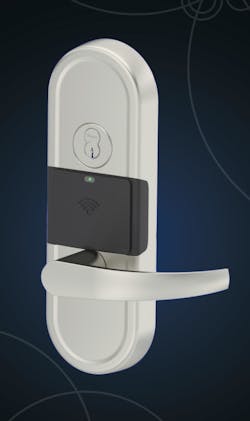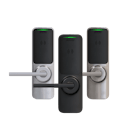Top 10 Wireless Lock Questions to Ask Before Buying
Much has been made over the last decade about wireless locks and the effort by lock manufacturers to bring access control to the countless number of interior doors in a facility. However, many options available today offer wireless in name only. It typically takes a whole lot of costly wires in the form of powering and connecting wireless access points in order to make a lock wireless at the door.
Most would agree that key control issues causing poor security and expensive rekeys due to lost, stolen or duplicated keys is a bigger problem than ever. There are now thousands of 3D key printing kiosks in hardware retail chains that can duplicate most ordinary keys – and some card credentials – without authorization. Fortunately, there are a number of access control products appearing on the market to combat the weaknesses of these traditional lock and mechanical key systems. The challenge for security professionals is how to choose the right smart lock or wireless access control system.
The following 10 questions should serve as a guideline for asking the right questions when investigating potential wireless locking solutions.
1. Is the wireless lock ANSI Grade 1 rated?
ANSI Grade 1 is the standard for any commercial, industrial or institutional facility in the United States today. It makes no sense to invest in a product that features access control functionality and then install a low cost smart lock that is easily defeated by simple picking or other low cost vulnerabilities. Demand Grade 1 protection as a starting point when developing the requirements for your wireless system. Important features to consider related to this question of quality are:
- High security keyway for emergency key over-ride;
- High security cylinders or pick-resistant (spool) pin segments in a 6 or 7-pin cylinder; and
- A clutch mechanism lever or other attack-resistant lever handle.
2. Will the wireless lock report tampering and key override?
Just like online electronic access control, wireless locks are only as secure as the key override included with them. Understanding whether a wireless lock has a method of reporting tampering such as entrance by a mechanical key, picking, etc., should be an important factor in any decision. For life safety reasons and protection against electronic failure, key override is an important feature. However, keys should not be used or distributed except in an emergency. Otherwise, security is no greater than a standard pin-tumbler lock system and compromises the security of any wireless lock. Can your system detect each time the lock/door was accessed and reported (audit trail)?
3. How secure is the credential?
Many card technologies that were available just a few years ago can easily be duplicated today. Does the wireless lock system utilize a credential technology that has been hacked? This may be the most important and yet overlooked question on this list. Virtually all credentials can be hacked with $30 equipment purchased online. Choose DESfire EV2, 3 or SEOS credential technologies with multiple layers of encryption.
4. How many communication protocols does my wireless lock use?
Most wireless locks can communicate via Bluetooth, RFID, Wi-Fi or some other wireless protocol. Be careful in choosing a system that only utilizes Bluetooth as a mobile credential. Mobile phones are typically a personal device of an employee who may deny use of their phone as a corporate credential, so it is advisable to have secure RFID credentials (cards, fobs, etc.) as an option to issue to such employees. Consider adding a biometric or PIN codes for dual authentication for higher security areas. Avoid PIN codes as a single authorization device for security reasons.
5. How do I retrieve information from my wireless lock?
Understanding how to update wireless locks with new information and retrieve activity logs and audit trail information is a critical question to answer when considering a wireless lock deployment. Many wireless locks today require a heavy infrastructure investment in order to talk to them or they claim to be able to leverage the existing Wi-Fi network in a facility.
The key here is understanding how often you can communicate and what is required in order to capture data that resides in the lock. You should always ask: Does it require traveling to the lock and, if so, will this option meet your customer’s requirements? In addition, understanding if there are other options to communicate to the locks on demand … Mobile Credentials, Wi-Fi, BLE bridges, Data-on-Card, etc. … and the cost of this added connectivity will be important in any final decision around a wireless lock investment.
6. What is the future capability of the wireless lock?
When technology advances so quickly, future-proofing any investment made in wireless locks may prove challenging. Any current or future capability of turning the off-line or wireless locks into online doors for real-time communication will be critically important. Asking if online doors are required and if they are compatible with the wireless locking system are important questions to get answered as part of the decision-making process.
7. Will the wireless lock work on all major door applications?
Every facility is unique, but most door openings and locking systems fall into four major categories: Cylindrical, mortise, panic and storefront. Any wireless lock solution being considered should have an effective and thorough way of addressing each of these types of applications. This capability is not always a given, so be sure to research these application, especially when retrofitting existing openings to ensure a successful implementation. Are any auxiliary locks (gates, padlocks, cabinet locks, etc.) required?
8. Is the wireless lock system scalable?
Many wireless locking systems are limited as to the number of users and the number of locks available, so be sure the system you select is scalable to your customers’ needs. Understand how the management software works and how easily doors and users can be added, changed or deleted.
9. How does the wireless lock consume power?
One of the limitations of a wireless locking system is power consumption. Wireless systems typically require battery-operated locks and systems vary wildly in how power is consumed, affecting battery life and the frequency at which batteries need to be changed. Understanding cycle testing results and how often you will need to change batteries in a typical system is important because it can translate to added labor costs. For instance, Wi-Fi can talk to more devices in a system but typically uses many (up to 20) times the power requirements in comparison to BLE, so knowing the power draw for the number of times you need to connect or communicate to the lock is important.
10. What are the recurring charges or costs?
When comparing access control functionality with standard locks, price is an important factor for your customer. One of the most important questions is: Are there ongoing or recurring costs associated with systems you are comparing? If so, calculate these into your pricing. These may result in recurring revenue for the installer.
I’m old enough to remember receiving one of the original INC magazines with a fairly unknown, 27-year-old man by the name of Steve Jobs on the cover (his first magazine cover), claiming that typewriters would soon be replaced by desktop computers. It seemed fairly outrageous to most people at the time.
Forty years later, the locking industry is still using technology (pin-tumbler locks) invented by Linus Yale in 1861 as the industry standard. Wireless lock technology is ready to challenge the status quo as the next generation of security to all doors, not just the perimeter doors.
Jeff Cahill has spent more than 40 years in the locking hardware and access control industries, including 20 years with Best Locking Systems, was one of the founders of XceedID Corporation and is the founder and majority owner of Proxess, LLC, a wireless locking/access control platform, www.proxess.com.






